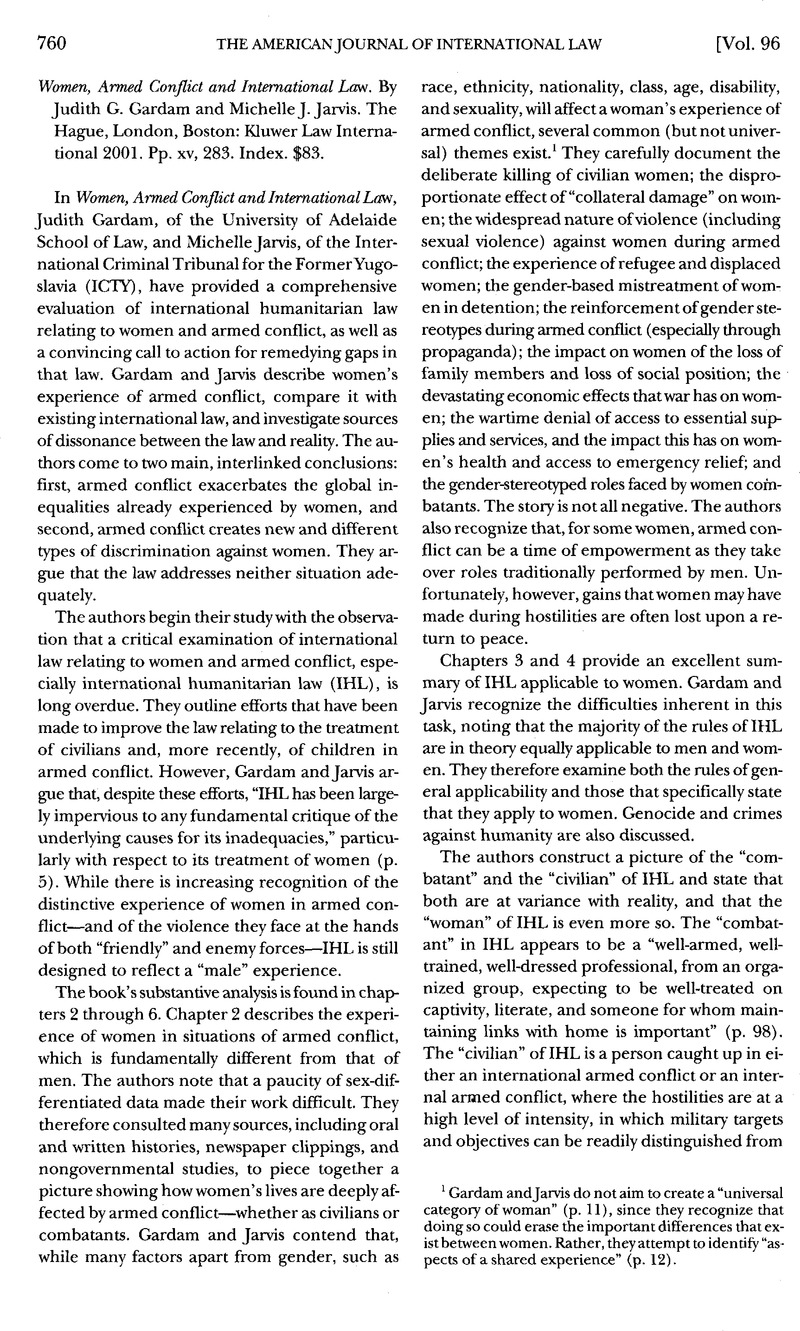Published online by Cambridge University Press: 27 February 2017

1 Gardam and Jarvis do not aim to create a “universal category of woman” (p. 11), since they recognize that doing so could erase the important differences that exist between women. Rather, they attempt to identify “aspects of a shared experience” (p. 12).
2 For example, the authors describe the Čelebići judgment of the ICTY (Prosecutor v. Delalić, No. IT-96-21- T, Judgment (Nov. 16, 1998)).
3 For example, the authors describe the Akayesu judgment of the ICTR (Prosecutor v. Akayesu, No. ICTR-96- 4-T, Judgment (Sept. 2, 1998)).
4 For example, the authors describe the Akayesu case, in which forced public nudity was found to be an “inhumane act.”
5 See, for example, the Mpambara, Bisengimana, and Niyitegeka indictments by the ICTR.
6 In this case, Kunarać was found guilty of keeping Muslim women in a house for several months, during which time they were treated as his private property. They were forced to cook and clean, as well as submit to ongoing rape by Kunarać and others. Codefendant Kovač was found guilty of keeping Muslim women in his apartment, during which time he treated them as his personal property and forced them to do household chores. They often went hungry, and they were frequently beaten and raped by Kovač and other soldiers. Kovač was also found guilty of “loaning” and selling Muslim women (including a 12-year-old girl) to other men. Prosecutor v. Kunarać, Nos. IT-96-23-T & IT- 96-23/1-T, Judgment (Feb. 22, 2001) [hereinafter Kunarać trial judgment].
7 Id., paras. 539-40. This finding was confirmed on appeal, Nos. IT-96-23-A & IT-96-23/1-A, para. 124 (June 12, 2002). However, the appeals chamber indicated that it prefers the following language: “a person over whom any or all of the powers attaching to the right of ownership are exercised.” Id., para. 118.
8 Kunarać trial judgment, supra note 6, para. 440.
9 Prosecutor v. Kvočka, No. IT-98-30/1-T, Judgment, paras. 546-61 (Nov. 2, 2001)
10 Id., paras. 546, 559-61.
11 Prosecutor v. Akayesu, No. ICTR-96-4-A, Judgment (June 1, 2001).
12 Prosecutor v. Musema, No. ICTR-96-13-A, Judgment (Nov. 16, 2001).
13 See Preparatory Commission for the International Criminal Court, Finalized Draft Text of the Elements of Crimes, UN Doc. PCNICC/2000/l/Add.2 (2000), elements for7(l)(g)-4,-5;8(2)(b)(xxii)4,-5;8(2)(e)(vi)-4,-5.
14 Preparatory Commission for the International Criminal Court, Finalized Draft Text of the Rules of Procedure and Evidence, UN Doc. PCNICC/2000/1 /Add. 1 (2000); see, e.g., id., Rules 16-19, 70, 71, 87, 88.
15 Id., Rules 85, 89-93, 94-99.
16 See International Committee of the Red Cross, Women Facing War (2001), at <http://www.icrc.org> (study of impact of armed conflict on women).